Contents
Plum Startovaya is a high-yielding variety loved by many gardeners. The fruits of this plum are fragrant and sweet. Trees are almost not subject to diseases and pest attacks.
History of variety breeding
The All- Research Institute named after I. V. Michurin was engaged in the breeding of the home Starting Plum. Breeders G. A. Kursakov, R. E. Bogdanov, G. G. Nikiforova and T. A. Pisanova crossed the Eurasia-21 and Volga Beauty varieties, as a result of which this variety appeared. The starting plum was introduced into the State Register in 2006.
Description of the plum variety Startovaya
- The height of the Starting Plum tree is average.
- The crown is dense, oval.
- Shoots Starting red-brown, with a silvery coating. The kidneys are cone-shaped, silvery-brown in color.
- The small, oval-shaped emerald leaves have a wrinkled texture and a pointed tip. Small ribs are located along the edges of the sheet of the Starting Plum. The stipules of the plant fall off early.
- Petioles normal, slightly pigmented. The glands have an amber hue and are located one at a time on the petiole.
- The starting plum blooms with large white flowers resembling a bell. Their anthers are located under the stigma of the pistil.
- The fruits of the Startovaya variety are large, have a dark purple color and a whitish tint. They are distinguished by high taste qualities (average tasting score – 4,7 points out of 5). The fruits are sweet and sour. The stone is large, oval, it is easy to separate it from the juicy yellow pulp. On average, the fruit of the Starting Plum reaches a mass of 52 g.
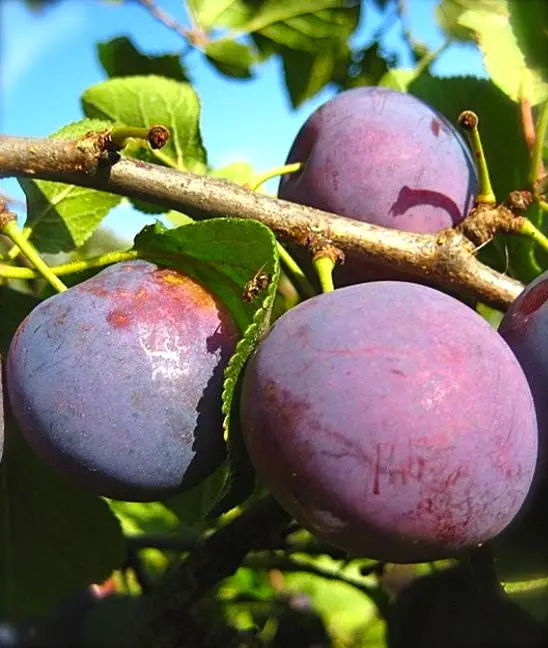
The starting plum is grown in the Central Black Earth region of Our Country, in Ukraine, in the south – in Georgia and Moldova, in the north – in Estonia. Loamy soils are ideal for growing.
Plum characteristics
Drought and frost resistance
The starting plum has frost resistance, with mild winters there is no need to cover the tree for the winter.
Plum loves heat and calmly tolerates heat, although it requires additional watering.
The most positive reviews about the Startovaya plum are in the Moscow region, where the climate is temperate, but the reviews about the Startovaya plum in Siberia are contradictory: only with careful care can you save the seedlings and get a good harvest.
Plum pollinators
Plum Starting is considered self-fertile, but it gives very few ovaries. To get a good harvest, Startovaya plum needs a pollinator. As pollinators, it is best to choose the parents of the variety: Eurasia-21 plum and Volga beauty.

Yield and fruiting
The plum variety Startovaya ripens very early and bears fruit. Its yield is about 61 centners of fruits per hectare (up to 50 kg per tree).
Shelf life is approximately 3 weeks (no more than 25 days).
For the first time, the plum bears fruit 4–5 years after planting the cutting or 6 years after planting the seed.
Scope of berries
Plum variety Starting is universal. It is grown by private gardeners for home use, and owners of large lands for fresh sale, and farms for the production of various products: wines, candied fruits, jams, compotes, mousses.
The fruits of the Startovaya variety can be frozen without loss of taste.
Disease and pest resistance
Variety Startovaya has resistance to diseases and pests, therefore it does not require treatment with fungicides and insecticides.
Advantages and disadvantages of the variety
Advantages:
- early fruiting;
- high yield;
- resistance to low and high temperatures;
- ease of transportation of berries;
- high taste qualities;
- versatility of use;
- immunity to diseases and pests.
Disadvantages:
- conditional self-fertility of plum Starting.
Features of landing
Recommended dates
The starting plum should be planted in late March – early April (2nd-3rd decade) or from September to mid-October, before frost sets in. In autumn, seedlings do not respond to damage to the root system. At the same time, it is easier to buy high-quality planting material.
Planting material planted in spring has time to develop the root system and easily survives the winter.
Choosing the right place
- Best of all Startovaya grows on loam.
- Ideally, the acidity of the soil should be in the region of 6,5–7 units. It is easy to check it with the help of litmus paper, for this it is enough to attach the meter to a handful of damp earth after rain.
- Starting should not be planted in a place where the groundwater level exceeds 2 meters: the drain is sensitive to excess ground moisture.
- It is best to plant it in a place where it will be constantly under the rays of the sun and protected from the northern winds.
Under such conditions, the fruits of Startovaya will ripen sweet and juicy.
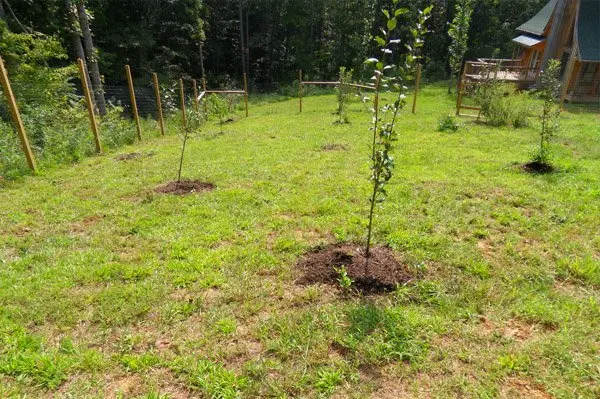
What crops can and cannot be planted nearby
- Another plum variety compatible with it should be planted next to Startovaya. Eurasia-21 and the Volga beauty, which are its best pollinators, are best suited.
- It makes no sense to plant nearby plums of varieties that do not coincide with this variety in terms of flowering time.
- Plum should not be planted next to cherries, cherries, pears, walnuts.
- She gets along well with an apple tree or berry bushes: raspberries, currants.
Selection and preparation of planting material
It is very easy to grow a starting plum from a stone or from a cutting. Planting from the bone will be cheaper and easier.
- The bones are split, the seeds are removed and they are pre-soaked in warm water for 70–120 hours, changing the water once a day.
- After that, the bones are stored in a clean glass container.
- 6 months before planting, the seeds are stratified in wet sand at a temperature ranging from -10 to 1 degree.
- 2 years after planting, the stalk, if necessary, can be transplanted to another place.
Today on the market you can find
- seedlings grafted on seed stocks;
- rooted seedlings;
- seedlings grown from root shoots, cuttings, layering.
For the Starting Plum, it is best to buy own-rooted planting material: a fruitful tree will grow out of it, consistently giving a bountiful harvest and easily tolerating frost.
For planting, one-year and two-year-old seedlings are suitable.
The indicators that are important when choosing are described in the table.
Age, branching | Height | Barrel diameter | Length of main branches |
1 year, unbranched | 110-140 cm | 1,1-1,3 cm |
|
1 year branched | 40–60 cm (stem height) | 1,2-1,4 cm | 10-20 cm |
2 years, branched | 40–60 cm (stem height) | 1,6-1,8 cm | 30 см |
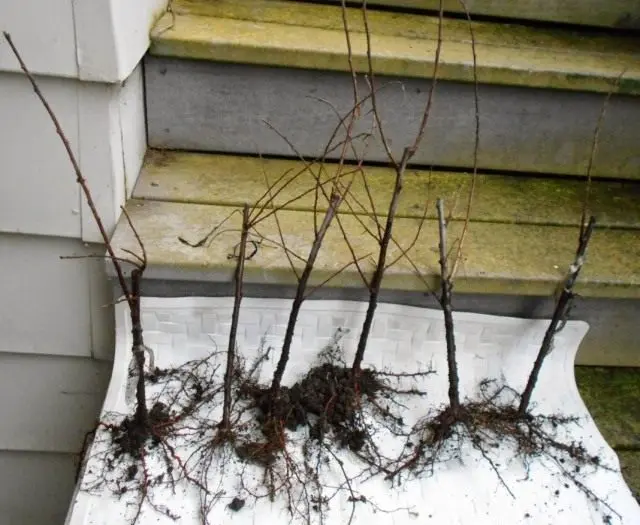
Landing algorithm
When planting seeds, you need to wait until they germinate in the process of stratification. It is also necessary to prepare a sufficient amount of drained soil and compost.
- When the roots are visible, the seeds should be planted in a pot or immediately on the site, after digging a hole.
- In the center of the hole, you should make an elevation from the ground, place the seed there, carefully spread out the roots and bury the seed.
When planting seedlings in the spring, the pits for the Starting Plum are prepared in the fall. At the same time, it is easiest to buy seedlings, since at this time the market offers the widest selection of planting material. They should be kept buried until planting. If it is decided to plant a plum in the fall, the pits should be prepared a month before planting.
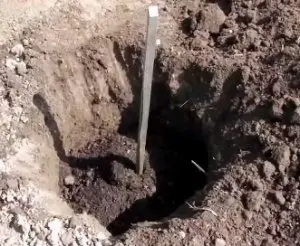
- Plums are best planted at a distance of 3–4 m from each other and 5–6 m between rows. Starting plum trees in Siberia and the Far East should be at a smaller distance – 2-3 m from each other and 3-5 m between rows.
- The pits should be 70–80 cm in diameter and 70 cm deep.
- When digging, the top layer of soil should be placed in one direction, the bottom layer in the other.
- If the soil is peat or sandy, the hole should be filled to a 10-centimeter level with clay.
It is also best to fertilize the soil before planting. The recommended composition of the fertilizer is as follows:
- humus and compost – 2 buckets;
- peat – 2 buckets;
- superphosphate – 1 tablespoon;
- urea – 3 tablespoons;
- potassium sulfate – 3 tablespoons.
This mixture will help the Starter Plum to take root faster and better. You should also add 2 cups of nitrophoska and 200 g of wood ash (an alternative to ash is fluff lime, dolomite flour).
With increased acidity of the soil, you need to add saltpeter with lime and ammonia, this will saturate the earth with nitrogen.
- If the soil is heavy, loosen the bottom of each hole to a depth of 20–25 cm.
- 20 kg of prepared fertilizer should be mixed into the removed top layer of soil.
- A 110 cm peg is dug into the bottom of the pit.
- An eggshell is placed in the pit, then it should be covered by two-thirds with a mixture of earth and fertilizer. If the mixture is not enough, you need to take some more earth from the topsoil.
- The seedling needs to spread the roots and place it in the hole.
- The pit is filled to the end with ordinary earth without any fertilizer.
- Thoroughly tamp the soil: this will protect the roots from contact with air and, therefore, drying out.
- In order for the Startovaya plum to absorb moisture to the maximum, you need to make an embankment around the seedling from the lower soil layer.
- The seedling should be tied to a peg and watered abundantly (3-4 buckets of water).
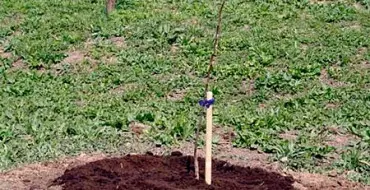
Plum Aftercare
Trimming
The highest yield is given by the Starting plum with the correct crown. For its formation, it is necessary to prune from the moment of planting.
- In the first year, the trunk is cut to a level of 1–1,2 m.
- For biennial plums of the Startovaya variety, the most powerful branches are cut to a length of 25–30 cm.
- In the third year, the apical growths are cut off by 30 cm, the lateral growths by 15 cm.
As a result, the Startovaya plum should have 5-6 branches growing at an angle of 50 degrees. The cup-shaped form should be maintained and the density of branches should not be allowed: this is fraught with a lack of light for ovaries and fruits and, consequently, a decrease in yield.
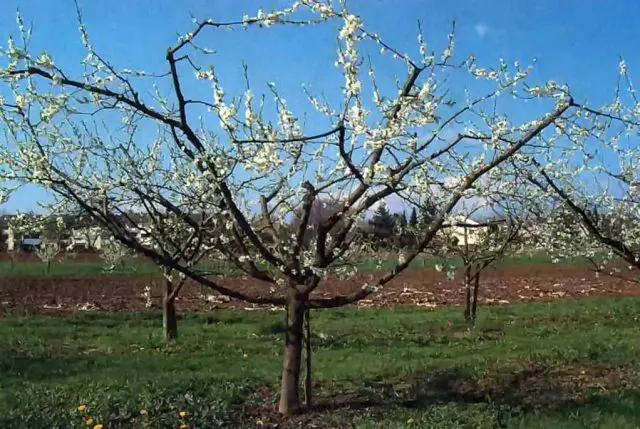
Watering
Plum grows well in conditions of excess moisture, so Startovaya should be watered regularly, especially for newly planted plants. Watering is especially important for spring seedlings, as the earth dries quickly in the warm season. For mature trees, one watering per week is enough. A young plum Startovaya needs 5-6 buckets for watering, a fruit-bearing plum – up to 10 buckets. In autumn, plums also need watering.
Preparation for winter
Plum Startovaya easily tolerates mild winters and does not require warming, however, if grown in the northern and northwestern regions, preparation for winter is necessary.
- Plum Starting should be whitened, this will somewhat protect it from frostbite.
- Around a young tree, you need to lay out several bags and fix them with soil. In especially severe frosts, it is necessary to lay several layers of burlap.
- An adult tree can be insulated by mulching with humus.
- The trunk circle of a young Starting Plum is covered with polyethylene to minimize the harmful effects of precipitation.
- After the first snow, a snowdrift is made around the base of the trunk for additional insulation.
- It is necessary to trample snow around young trees, this will protect them from rodent attacks.
- In heavy snow, it must be knocked down from the branches to avoid breakage.
By the end of February, you need to remove the strapping from the plums, take it out of the garden, and remove the snow from the trunks.
Additional fertilizing
The starter plum needs 3 fertilizers per year: in spring, summer and immediately after harvest.
The Starting variety should be fed
- urea;
- superphosphate;
- wood ash;
- phosphates;
- nitrogen fertilizers.
Protection against rodents
Most rodents make moves at a depth of 10–20 cm. Reliable protection against their attacks will be a chain-link mesh dug around the Starting Drain by 40–50 cm. The diameter of such a mesh should be 60–70 cm. This will not interfere with the root system, but the tree will be securely protected.
An alternative option is to set up traps. Depending on the type of animal, vegetables and herbs, bread fried in vegetable oil, lard can be used as bait. Also, this bait can be treated with poison and laid out on the site. There are also specialized preparations, such as Ratobor, which is very attractive to pests with its taste and smell and is convenient to use.
Diseases and pests, methods of control and prevention
The variety is not susceptible to most diseases and mass attacks of pests, therefore it does not require annual preventive procedures. Treatment with chemicals is necessary only when symptoms of a particular ailment are detected.
Conclusion
The starting plum is a rather unpretentious and fruitful variety. It has high taste qualities and a universal purpose, therefore it is suitable for mass and private cultivation and will require relatively little effort and investment. The variety is optimal for climates with mild winters, loves the sun. In the first years of life, it is necessary to protect the Startovaya variety from rodents, in the future, prevention is not required, and the fight against diseases and pests is reduced to situational treatment with chemicals.









